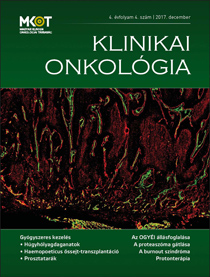The eLitMed.hu medical portal uses computer cookies for convenient operation. Detailed information can be found in the Cookie-policy.
Clinical Oncology - 2017;4(04)
Content
[Complex therapy of bladder cancer]
[Bladder cancer is the most common malignancy involving the urinary system. Urothelial (formerly called transitional cell) carcinoma is the predominant histologic type in the developed countries, where it accounts for approximately 90 percent of all bladder cancers. The optimal management of nonmuscle invasive urothelial cancer is highly important. For patients with muscle invasive cancer the gold standard treatment is the cystectomy. If the patient unable or unwilling to undergo radical cystectomy with urinary diversion, complete TURBT combined with radiation therapy plus chemotherapy may offer an alternative bladder-sparing approach. Patients with muscle invasive disease and regional lymph node metastasis limited to the pelvis (N1-N3), but without more distant lymph node or visceral metastasis may be treated with six cycles of cisplatin-based chemotherapy followed by cystectomy or a combined-modality approach. In metastatic cases the combination chemotherapy may prolong survival and often provides palliation of symptomatic disease. Checkpoint inhibition immunotherapy has substantial clinical activity in post-chemotherapy patients and is the preferred therapy for patients who have progressed after platinumbased therapy or is not suitable for them.]
[Hematopoetic stem cell transplantation for pediatric non-hematological solid tumors]
[High-dose chemotherapy followed by stem cell rescue or allogeneic stem cell transplantation in the treatment of solid tumor with non-hematologic origin applied for more than three decades. High-dose chemotherapy with stem cell rescue is the part of standard fi rst line therapy for several chemosensitive tumors with unfavorable outcome (neuroblastoma, Ewing-sarcoma, medulloblastoma), and also successfully applied in certain therapy-resistant or recurrent solid tumors (germ cell tumors, Wilmstumor). Allogeneic transplantation with reduced intensity conditioning is still not successful in terms of survival in pediatric solid tumors with non-hematological origin. In present paper results of autologus and allogeneic stem cell transplantation in different pediatric solid tumor are discussed.]
[Current treatment therapy of prostate cancer]
[Prostate cancer is a frequent and usually slowly progressing malignancy. Promising opportunities and risks to avoid may occur along its diagnosis and treatment. The chance of early detection is high. The localised disease can be cured by radical prostatectomy and radiotherapy with equal probability. The post-prostatectomy biochemical failure may be controlled by radiotherapy. Even oligometastatic tumours can be cured by harmonised local treatment modalities. The survival of metastatic disease can be prolonged by several years. Effi cacy of traditional androgen deprivation may be enhanced with completion by upfront docetaxel chemotherapy or androgen synthesis blocking agents. However, local and systemic treatments are not harmless. Overtreatment as well as undertreatment has to be avoided upon therapy planning.]
[Inhibition of proteasome in cancer therapy]
[The ubiquitin-proteasome pathway is the most important element in the regulation of intracellular protein metabolism. Its main function is the degradation of the unnecessary proteins either as part of normal metabolic balance or in case of misfolding or part of the deregulation as in cancer cells using proteolytic enzymes. The importance of this pathway has been acknowledge by Nobel prize. In certain diseases as in several malignancies, where the ubiquitin-proteasome pathway is not able to remove the proteins due to dysfunction or accumulation in a high quantity. The unregulated accumulation of proteins could lead to cell death. This phenomenon was proven by the appearance of proteasome-inhibitors targeting mainly myeloma. It should be mentioned that clinical aspects myeloma has been discussed in an excellent review by Mikala and his colleagues in Klinikai Onkológia.]
[Burnout syndrome - prevention and treatment]
[The defi nition of burnout syndrome was established due to the recognition of changes that practising physicians experienced in their affective state and behaviour as well as the observation of physical symptoms that put their health at risk. Burnout syndrome can be characterised by a triadic set of factors: emotional exhaustion, depersonalisation, and decline of professional achievement. The present article aims to describe burnout syndrome with regard to the fact that similarities and differences between burnout syndrome and affective disorders such as depression must be highlighted. The focus of this article is that health care professionals burnout is multicausal and it is insuffi cient to put only the individual in the spotlight although it is imperative that we attend to the individual fi rst. It is essential to highlight the fact that without changes in the institutional work culture and requirements the prevalence of burnout syndrome can hardly decrease. It is also the aim of this work to provide the practising health care professional with information that they can easily transform into immediate help.]
[Protontherapy]
[Radiotherapy with protons is a promising technology in the fi eld of modern radiation oncology. From a physical point of view, radiotherapy with protons has important advantages compared to the currently used photons due to its unique energy absorption profi le, which may result in a better local tumor control and reduced radiation-induced side effects. Increasing number of patients is treated with protons and carbon-ions. Our report aim to present the current status of proton radiotherapy including physical and technological aspects, standard and non-standard indications, ongoing clinical trials and the proton vs. photon debate in terms of patient selection.]
1.
Clinical Neuroscience
[Headache registry in Szeged: Experiences regarding to migraine patients]2.
Clinical Neuroscience
[The new target population of stroke awareness campaign: Kindergarten students ]3.
Clinical Neuroscience
Is there any difference in mortality rates of atrial fibrillation detected before or after ischemic stroke?4.
Clinical Neuroscience
Factors influencing the level of stigma in Parkinson’s disease in western Turkey5.
Clinical Neuroscience
[The effects of demographic and clinical factors on the severity of poststroke aphasia]1.
2.
3.
4.
5.



